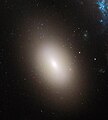| NGC 2937 | |
|---|---|
 | |
| Observation data (J2000 epoch) | |
| Constellation | Hydra |
| Right ascension | 09h 37m 45s |
| Declination | +02° 44′ 50″ |
| Distance | ∼343 million ly |
| Apparent magnitude (V) | 13.66 |
| Apparent magnitude (B) | 14.6 |
| Surface brightness | 22.84 mag/arcsec² |
| Characteristics | |
| Type | E3 |
| Other designations | |
| ARP 142,
PGC 27423, UGC 5131, MCG 1-25-6, CGCG 35-15, VV 316, NPM1G +02.0225 | |
NGC 2937 is an elliptical galaxy located in the constellation Hydra. Its velocity relative to the cosmic microwave background is 105.1 ± 7.4 km/s, which corresponds to a Hubble distance of 105.1 ± 7.4 Mpc (∼343 million ly).[1] NGC 2937 was discovered by German astronomer Albert Marth in 1864.
NGC 2937 is in a strong gravitational interaction with its neighbor NGC 2936, a peculiar spiral galaxy . This interaction has given the latter an appearance that is far from that of a spiral galaxy. The shape of NGC 2936 has earned it the nickname of the "porpoise galaxy".[2]
Together, these two galaxies appear in Halton Arp 's Atlas of Peculiar Galaxies under the code Arp 142.[3] Halton Arp uses them as an example from an elliptical galaxy.[4] This pair of galaxies also appears in the Catalog of Collisional Ring Galaxies by Madore, Nelson and Petrillo.[5]
Image gallery[edit]
-
James Webb Space Telescope image of NGC 2937.
-
Hubble Space Telescope image of NGC 2937.
See also[edit]
External links[edit]
References[edit]
- ^ "By Name | NASA/IPAC Extragalactic Database". ned.ipac.caltech.edu. Retrieved 2024-07-03.
- ^ "APOD: 2017 February 6 - The Porpoise Galaxy from Hubble". apod.nasa.gov. Retrieved 2024-07-03.
- ^ "New General Catalog Objects: NGC 2900 - 2949". cseligman.com. Retrieved 2024-07-03.
- ^ "New General Catalog Objects: NGC 2900 - 2949". cseligman.com. Retrieved 2024-07-03.
- ^ Madore, Barry F.; Nelson, Erica; Petrillo, Kristen (2009-03-25). "ATLAS AND CATALOG OF COLLISIONAL RING GALAXIES". The Astrophysical Journal Supplement Series. 181 (2): 572–604. arXiv:0902.4629. doi:10.1088/0067-0049/181/2/572. ISSN 0067-0049.
Sources[edit]
- Tully, R. Brent (2015-04-28). "GALAXY GROUPS: A 2MASS CATALOG". The Astronomical Journal. 149 (5): 171. arXiv:1503.03134. doi:10.1088/0004-6256/149/5/171. ISSN 1538-3881.
- Gil de Paz, Armando; Boissier, Samuel; Madore, Barry F.; Seibert, Mark; Joe, Young H.; Boselli, Alessandro; Wyder, Ted K.; Thilker, David; Bianchi, Luciana; Rey, Soo‐Chang; Rich, R. Michael; Barlow, Tom A.; Conrow, Tim; Forster, Karl; Friedman, Peter G.; Martin, D. Christopher; Morrissey, Patrick; Neff, Susan G.; Schiminovich, David; Small, Todd; Donas, Jose; Heckman, Timothy M.; Lee, Young‐Wook; Milliard, Bruno; Szalay, Alex S.; Yi, Sukyoung (2007). "The GALEX Ultraviolet Atlas of Nearby Galaxies". The Astrophysical Journal Supplement Series. 173 (2): 185–255. arXiv:astro-ph/0606440. doi:10.1086/516636. ISSN 0067-0049.
- Gottlieb S. (May 2017). "Galaxies in Collision". Sky & Telescope: 28–29. ISSN 0037-6604.


Well, that’s interesting to know that Psilotum nudum are known as whisk ferns. Psilotum nudum is the commoner species of the two. While the P. flaccidum is a rare species and is found in the tropical islands. Both the species are usually epiphytic in habit and grow upon tree ferns. These species may also be terrestrial and grow in humus or in the crevices of the rocks.
View the detailed Guide of Psilotum nudum: Detailed Study Of Psilotum Nudum (Whisk Fern), Classification, Anatomy, Reproduction